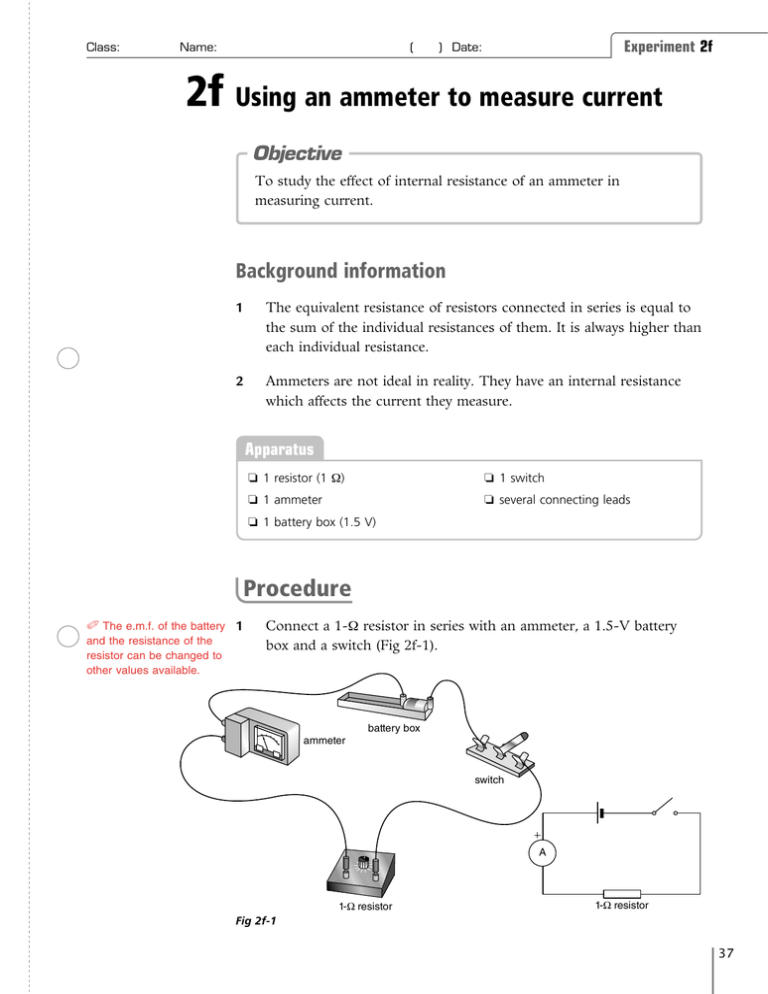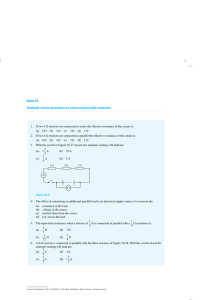2f Using an ammeter to measure current
advertisement

Class: Name: ( Experiment 2f ) Date: 2f Using an ammeter to measure current Objective To study the effect of internal resistance of an ammeter in measuring current. Background information 1 The equivalent resistance of resistors connected in series is equal to the sum of the individual resistances of them. It is always higher than each individual resistance. 2 Ammeters are not ideal in reality. They have an internal resistance which affects the current they measure. Apparatus ❏ 1 resistor (1 Ω) ❏ 1 switch ❏ 1 ammeter ❏ several connecting leads ❏ 1 battery box (1.5 V) Procedure ✐ The e.m.f. of the battery 1 and the resistance of the resistor can be changed to other values available. Connect a 1-Ω resistor in series with an ammeter, a 1.5-V battery box and a switch (Fig 2f-1). battery box ammeter switch A 1-8resistor 1-8resistor Fig 2f-1 New Physics at Work (Second Edition) © Oxford University Press 2007 37 Experiment 2f Class: ✐ Batteries which have been used for several times may provide an e.m.f. smaller than 1.5 V. In order to show the conclusion, Ts should buy a new package of batteries for the experiment, or check out the voltage across each battery with a voltmeter before the lesson, so that the e.m.f. provided by each battery is approximately equal to 1.5 V. Name: ( ) Date: 2 Measure the current I′ flowing through the resistor using the ammeter. ✎ 0.6 Current I′ through the resistor = ___________ A 3 Calculate the theoretical value of current I flowing through the resistor. ✎ 1.5 Theoretical voltage V across the resistor = ___________ V 1 Resistance R of the resistor = ___________ Ω Theoretical current I through the resistor = V R 1.5 1 ___________ = 1.5 = ___________ A Discussion ✎ What is the resistance of an ideal ammeter? 0Ω ✎ Compare the theoretical value I and the experimental value I′ of current flowing through the resistor. Account for the difference. The theoretical value I is much larger than the experimental value I′. An ammeter has an internal resistance. When it is connected in series with the resistor, the equivalent resistance in the circuit increases. Therefore, the current flowing in the circuit, which is the measured current, decreases. small A practical ammeter has a ________________________ internal resistance instead of zero. When it is connected in series in a circuit, the equivalent resistance of the circuit increases ________________________ and the measured current is smaller ________________________ than the theoretical current of the circuit. 38 New Physics at Work (Second Edition) © Oxford University Press 2007 Class: Name: ( ) Date: Experiment 2f Further thinking ✎ How does the accuracy of an ammeter in measuring current change with its internal resistance? Explain your answer. The larger the internal resistance of an ammeter, the lower its accuracy. When the internal resistance of an ammeter increases, the equivalent resistance in the circuit increases, so the current flowing in the circuit decreases. In this case, the difference between the measured value and the theoretical value of current increases. New Physics at Work (Second Edition) © Oxford University Press 2007 39





